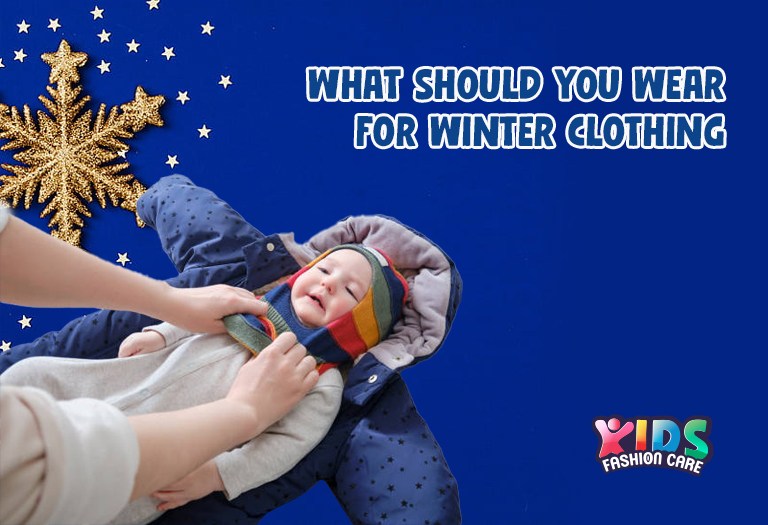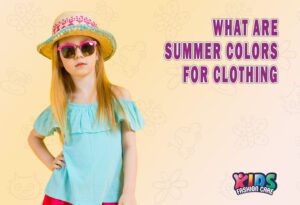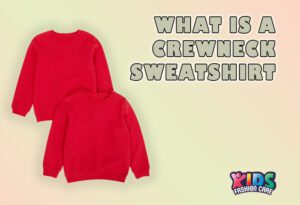Dress your kids with layers to stay warm in winter. You can start with long underwear and thermal leggings as your base layer. For the middle layer choose fleece-lined pants and a long-sleeve shirt for extra warmth. A thick sweater or coat will keep your kids’ body warm.
Accessories like wool socks, a winter hat, and gloves to protect your hands and feet. Choose water-resistant boots for snowy days.
Table of Contents
Kids have a tendency to catch cold more than adults. So, it’s important to cover them properly in winter, otherwise they can fall sick easily. As a fashion expert I love to style my kids be it any season. Though I’ve seen many parents around me struggling to choose the right winter wear for their children.
Over the years, I’ve learned how to dress my children for winter in ways that keep them warm and comfortable. In this blog, I will share my personal experience and tips to help you to find out what your kids should wear for winter. You have to dress them in a manner so that they move freely yet don’t catch cold. In this complete guide on what to wear in winter, I will break down every layer of winter dressing. I will discuss all the details you need to make the right decisions for your children.
What Should You Wear for Winter Clothing?
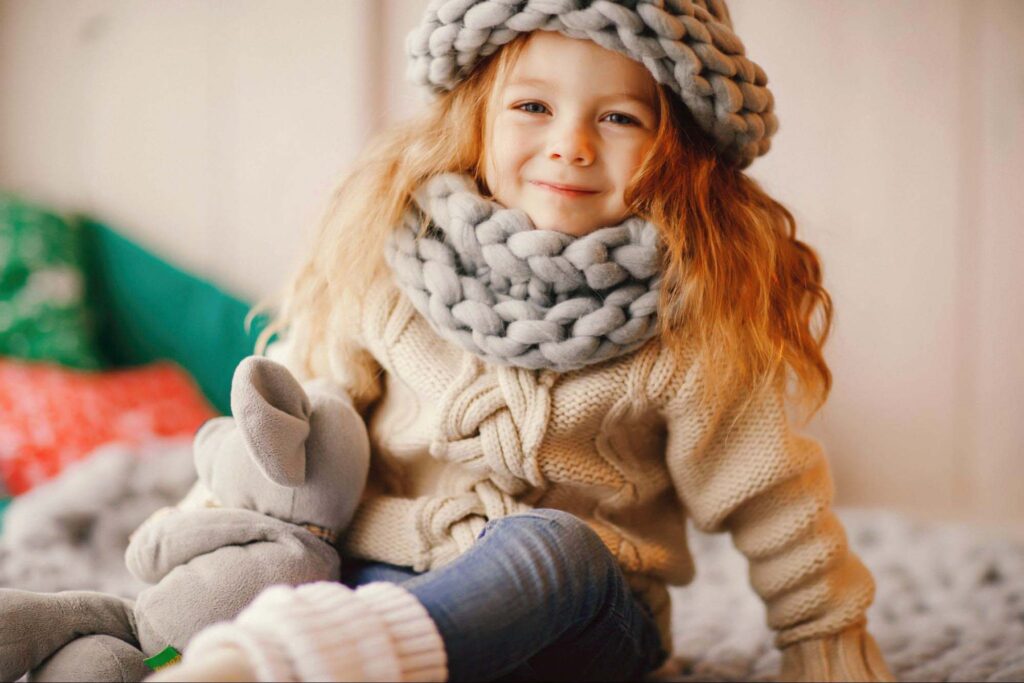
The most important thing you have to consider for winter clothing is it needs to be functional and protective, especially when you are dressing your kids. So, don’t make your kids too bulky with too many clothes, that might restrict their movement.
From my experience, I’ve found that layering is the most effective way to keep my kids warm. If you can layer kids properly it will allow flexibility. You can also add or remove clothing as needed. I suggest you start with natural fibers like merino wool for the base layer, and work your way up to heavier, protective outer layers. We’ll explore this layering method in more detail.
Magic of Three Layers
I found the magic formulas for winter dressing, and it’s all about three layers: base, middle, and outer. Each layer has a purpose in keeping kids warm and comfortable.
Base Layers
The base layer is the foundation of winter dressing. The base layer should keep your kid’s skin as dry as possible. Its job is to keep the skin dry by wicking away moisture. You have to choose a snug-fit for this layer which traps body heat.
How to Choose a Base Layer?
Merino wool or synthetic fabrics are a great choice for base layers. I prefer merino wool because it’s a natural fiber, which is smooth for kids’ soft skin. Merino wool is breathable and naturally moisture-wicking. I can assure you from my experience, whenever my kids wear merino wool, I notice they stay warm even if it’s snowing outside. For the base layer, try to stay away from cotton, as it absorbs moisture and can make your kids feel cold once wet.
Middle Layers
The middle layer acts as insulation. It traps body heat to keep kids warm in winter. For the middle layer you choose different types of fabric, from light fleece to down jackets. You need to choose the middle layer depending on how cold it is.
How to choose a middle layer?
I often go for fleece-lined clothing or lightweight down jackets for the middle layer. For the middle layer fleece is fantastic because it’s soft and retains heat well. When my kids go to school, I choose synthetic insulation or down-filled coats, which are great for holding warmth. Always make sure the middle layer fits comfortably over the base layer without being too tight. I buy a middle layer in a slightly loose fit for my kids as they will already wear a base layer underneath.
Outer Layers
The outer layer protects from wind, rain, and snow. This is where you’ll want something heavy-duty but breathable.
How to choose an outer layer?
I’ve found that water-resistant jackets or puffer coats work best in winter. For snowy or rainy days, a jacket with a hood and good water resistance is key. Look for options that offer breathability as well as insulation. A quality outer layer should keep moisture out while allowing sweat to escape, helping your child stay warm and dry.
Clothes to Wear During Cold Weather
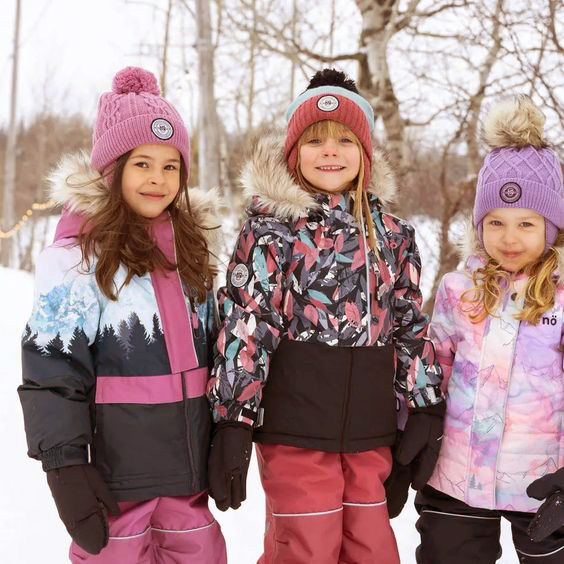
Long Underwear
Long underwear is the first layer I put on my kids during winter. It’s designed to fit snugly against the skin. It helps trapping body heat and providing a comfortable base. Its material is often lightweight but still gives excellent insulation to kids. I prefer long underwear for extra warmth whenever my kids are outdoors for a long period. While they’re playing in the snow or heading to school, they wear long underwear as a base layer and it ensures they have that essential warmth close to their body.
Thermal Leggings
Thermal leggings are made from insulating material. Insulating materials help to keep kids’ legs warm without making them feel bulky. They’re stretchy and soft, which means my kids can move around easily while they are in any activities. I find that thermal leggings are great for layering under heavier pants. They work excellently providing warmth but remain breathable. You can use thermal legging for your kids and they don’t overheat indoors.
Fleece-lined Pants
For the outer leg layer you can choose fleece-lined pants. My kids wear these pants and I’ve found them great for winter. Fleece lining provides additional warmth and softness.
The outer material of these pants is durable and blocks out wind and cold. That’s why they are perfect for playing or outside activities. They’re also flexible, so my kids can run, jump, and move freely while staying warm. Additionally, The fleece adds an extra cushion of warmth that regular pants can’t provide.
Merino Wool Socks
I always make sure my kids wear merino wool socks during winter. They are my kids’ winter essential because merino wool naturally regulates temperature and keeps their feet warm but not sweaty. The wool wicks moisture away from their skin, which helps prevent their feet from getting cold. Whether they’re walking to school or playing in the snow, these socks ensure their feet stay warm and dry all day.
Long-sleeve Shirts
I start with a long-sleeve shirt to cover my kids’ upper body in winter. This shirt acts as a comfortable layer directly against the skin. I prefer shirts made from soft and breathable materials like cotton or moisture-wicking fabrics. These fabrics help to keep kids warm and they don’t even feel too heavy. This shirt serves as a versatile piece, so kids can wear it under sweaters or just by itself when indoors. It provides a nice balance between warmth and comfort.
Sweater
Sweaters are classic winter wear. No winter can be complete without a sweater. My kids wear sweaters over long-sleeved shirts when it’s very cold outside. Sweater gives extra insulation. I choose the fabrics of the sweaters depending on the day. You can choose a thick wool sweater or a lighter cotton blend, depending on the temperature.
Sweaters are great for the middle layer if it’s snowing. You can layer a coat or jacket over a sweater if your kids need to go outside in the snow.. If we’re going outside, the sweater adds a necessary layer of heat retention and keeps my kids cozy underneath their coats.
Coats
The coat is the most important outer layer for keeping kids warm in winter. I look for coats that are insulated and often water-resistant or waterproof to protect my kids from snow and wind. These coats are usually thick and have enough padding to keep the warmth inside. Some of them have hoods for extra protection against the cold wind. Here is a pro-tip from me, always choose a coat that is long enough to cover kids lower back. It will keep them fully shielded from the cold.
Winter Accessories
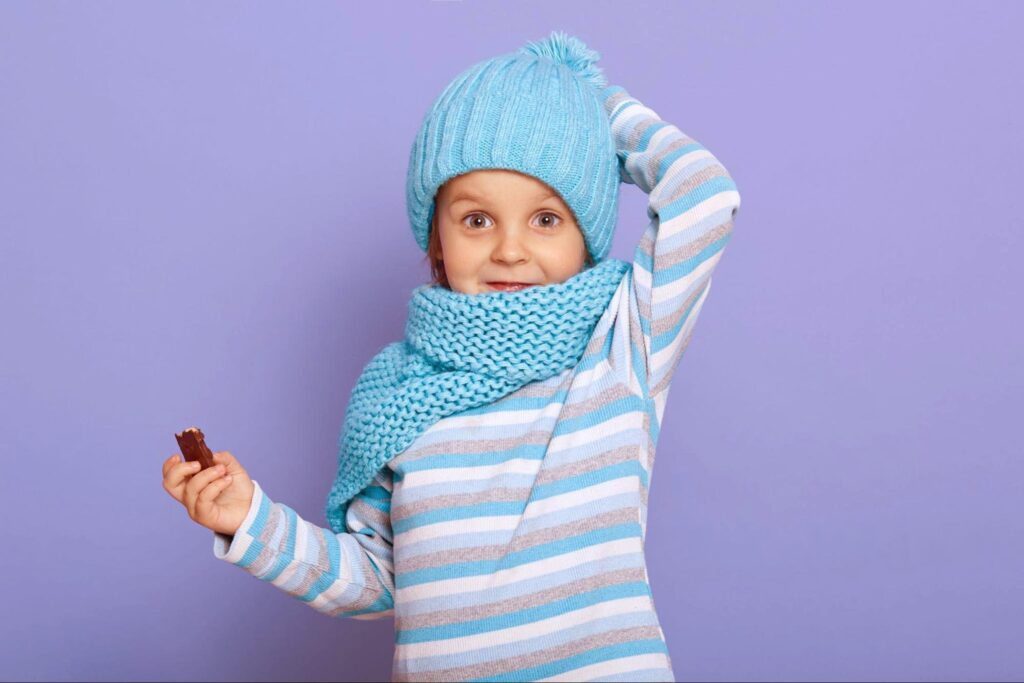
In winter accessories are just not for looking beautiful, they are essential to get protection from winter wind. Accessories are a must when it comes to staying warm in winter. Like a kid’s body their hands, feet, and heads need warmth as well.
Winter Hats: You can choose a fleece-lined or wool hat that covers the ears. It is non-negotiable for winter accessories. My kids love soft, cozy hats that don’t itch. So, I always buy 2 or 3 hats for my kids before winter comes.
Gloves or Mittens: A good pair of gloves is essential for winter outdoor play. Mittens keep hands warmer, but gloves offer more dexterity.
Scarves: When it’s particularly windy outside your kids must keep a scarf with them. A scarf can protect the neck and face from the cold.
Wool Socks: Wool socks keep feet toasty even in the snow. So, never forget to wrap your kids feet with good quality wool socks when it’s extremely cold.
Shoes for the Winter
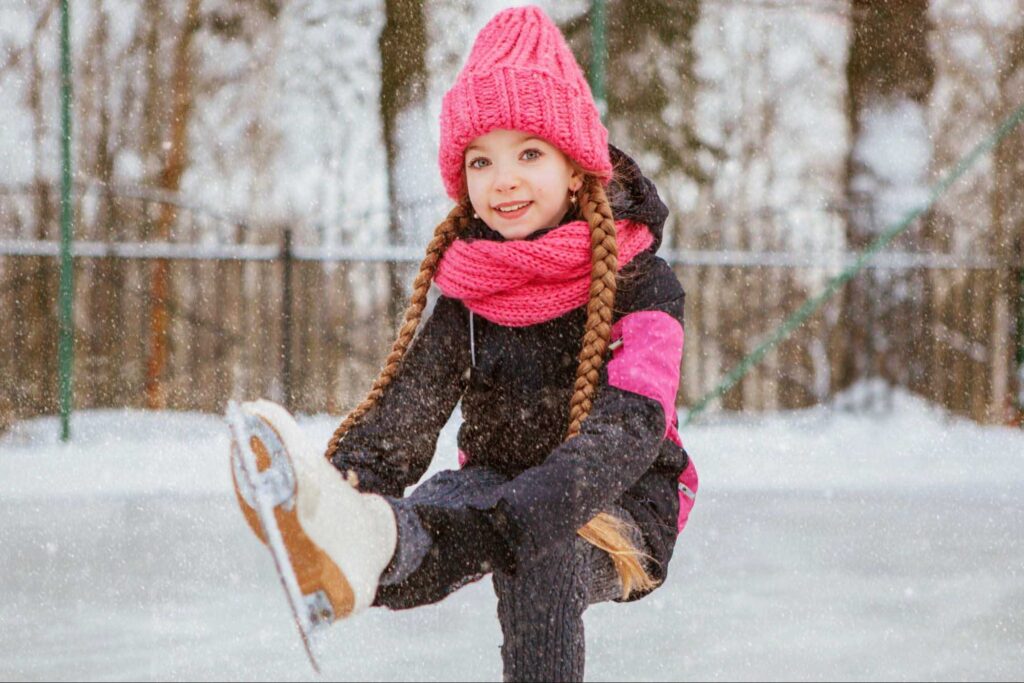
Footwear is one area where I never compromise in winter. The wrong shoes can quickly lead to cold, wet feet, and nobody enjoys that, especially kids. Some winter footwear works best for my kids and here why:
Snow Boots: Insulated, water-resistant boots are ideal for snowy weather. They keep kids’ feet dry and warm, no matter how deep the snow.
Winter Boots: When snow isn’t an issue then winter boots are great for everyday wear. You can look for boots with good insulation and a sturdy grip.
Hiking Boots: On dry but cold days, hiking boots work well, especially if they are water-resistant. They offer excellent support and warmth.
Wool or Fleece-lined Insoles: These insoles give extra warmth and comfort to any kids’ shoe.
Additional Layering Tips
If you can layer like a pro your kids might feel cold and uncomfortable even after wearing so many clothes in the cold season.
Dress in Layers: Always layer easy-to-remove clothing items, with chains and buttons. This allows flexibility. Moreover, if your kids get too hot, they can easily remove a layer.
Say No to Cotton in Winter: Cotton is not a good choice for winter. Cotton soaks sweat and doesn’t dry out easily. So, kids can catch a cold easily in winter by sweating.
Moisture-wicking Fabrics: For the base layer, always choose materials that wick moisture away from the skin. This helps keep kids dry and this is a key to staying warm.
Fleece-lined Clothing: Fleece-lined clothing is lightweight. They are very effective in holding heat without adding bulk.
Insulation Layer: Middle layer needs to provide sufficient insulation. Down or synthetic insulation works best as a middle layer for really cold conditions.
Outer Protection: The outer layer needs to block wind and moisture. So, look for water-resistant materials as outer layers.
Keep Hands and Feet Warm: Make sure gloves, socks, and shoes are appropriate for the cold. Wool and synthetic fibers tend to work better than cotton.
What are Winter Colors for Clothes?
Winter fashion is not just about staying warm but also about looking stylish. I like to dress my kids in winter colors that complement the season. Darker tones such as navy, black, and deep greens tend to work well. But winter fashion is not about just boring neutral colors, there’s always room for pops of color.
Neutrals: Gray, black, and white are staples in winter wear. They go well with almost any outfit and are timeless.
Bright colors: You can add a pop of red, orange, or bright blue that brings energy to any winter outfit.
Patterns: Fun patterns like plaid or stripes also work well for winter. These are classic winter patterns and suit both adults and kids.
Frequently Asked Questions (FAQs)
Question: How can I look fashionable in winter?
Answer: You can make your winter look fashionable and full of warmth. You can choose different types of accessories like fashionable winter hats, scarves, mittens etc. You can choose a sweater, jacket, coats, and other winter wear in different colors and patterns.
Question: How many layers should I wear in winter?
Answer: On a really cold day in winter you should wear three layers of clothes with appropriate accessories. Start with a base layer with a merino wool t-shirt. For the middle layer you can choose a fleece jacket or sweater as it retains the heat. And lastly for the outer layer you can choose water-resistant jackets or puffer coats.
Question: What not to wear during winter?
Answer: Cotton is not the perfect fabric for winter. Try to avoid cotton clothes in winter. Cotton absorbs humidity and doesn’t dry out quickly. This fabric can make you feel more cold.
Question: Which cloth is best for winter?
Answer: Fabrics like merino wool, cashmere, fleece, polyester work best for winter. Sweaters, jackets, coats made of these fabrics give warmth and comfort in the winter.
Conclusion
I don’t feel any stress while dressing my kids in winter. I follow 1 rule, that is covering my kids in 3 layers. In these layers I choose different types of design and colorful winter clothes. I choose winter outfits for my kids that balance functionality and style. And I never miss the essential accessories like gloves, hats, and scarves to cover my kids with more warmth.
In this blog I tried to help you from my experience and I hope this guide helps you make the best choices for your kids this winter.

